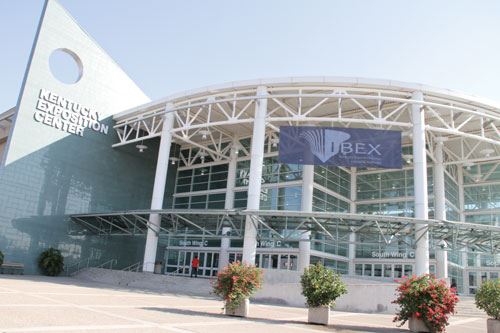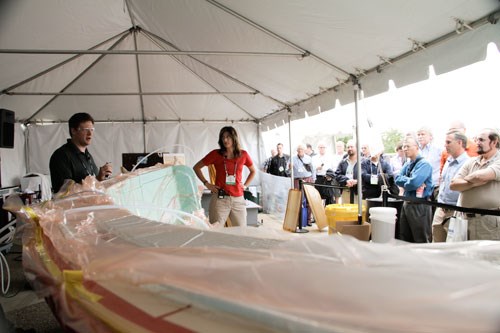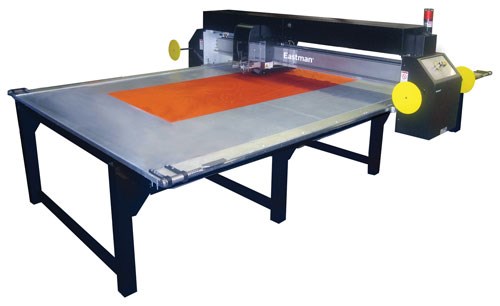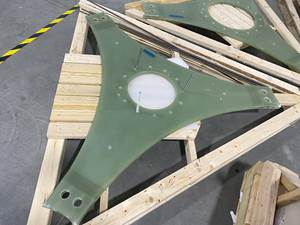IBEX 2010: Looking up in Louisville
A new location helps regenerate a recession-battered industry, drawing in more exhibitors and attendees than in 2009.
On the occasion of its 20th anniversary, the International BoatBuilders’ Exhibition & Conference (IBEX) was hosted, for the first time ever, outside southern Florida. The new location, the Kentucky Exposition Center in Louisville, Ky., on the banks of the Ohio River, appeared to be a plus: IBEX reported a 14 percent increase over 2009 in the number of exhibitors — to 546 companies, including 70 first-time participants. Attendance also was up, 13 percent to 5,161, and this show marked the first IBEX appearance of the Marine Aftermarket Accessories Trade Shows (MAATS) Aftermarket Pavilion. The positive statistics echoed the marine industry’s overall mood: glad to have the worst of the economic recession over and cautiously positive about the slow upturn as it begins to gain traction. The show’s theme, “Where the Business of Boating Gets Done,” was appreciated in the aisles by exhibitors and visitors who often described the show as the “three most productive days of the year” for boatbuilders.
CT was on hand for the event, and found a variety of new composites products and technologies on display.
_________________________________________________
Flexible, infusible 3-D core
3A Composites , a division of Schweitzer Technologies Group (Sins, Switzerland) exhibited BALTEK, AIREX and Lantor products. New this year is LANCORE, a “true 3-D flexible core material,” for resin transfer molding (RTM) Lite and vacuum infusion processes. The infusible core combines a polyester nonwoven with synthetic microspheres, then sandwiches that between two layers of chopped strand mat. The result reportedly offers improved cosmetics and part thickness consistency, but consumes less resin than other infusible cores, thus yielding a part that exhibits better quality at less weight. The material features a random printed-dot cell structure, so that the channels between cells act as a flow medium, but the material itself resists compression like a foam or balsa core. It is available in thicknesses from 2 mm to 5 mm (0.079 inch to 0.197 inch) and reportedly saves up to 25 percent in resin use compared to conventional RTM Lite mat products.
_________________________________________________
Fatigue-resistant vinyl esters
Ashland LLC (Dublin, Ohio) exhibited the AME 6001-, AME 5001- and AME 1001-series vinyl ester resins. AME 6001 is said to offer a 50 percent increase in tensile elongation and a 15 percent increase in tensile and flexural strengths over previous formulations and, as a result, offers greater resistance to fatigue failure. A reformulated version of AME 1001 also delivers significant improvements in fatigue life. AME 5001 is designed to provide excellent blister resistance. All three are intended for applications that require low hazardous air pollutants (HAPs) content. AME 6001 exceeds DNV Grade “1” mechanical properties, while AME 1001’s mechanical properties exceed DNV Grade “2” requirements. All three resins may be used in layup, sprayup or closed molding processes.
_________________________________________________
Reusable bagging system
Composites One (Arlington Heights, Ill.) maintained its leadership role in closed-molding demonstrations, featuring the new Flex Molding Process developed by Magnum Venus Products (MVP, Clearwater, Fla.). Flex Molding is a turnkey setup, which includes a mix/meter resin infusion system (eliminates mixed resin in buckets) that feeds directly into one or more Turbo Autosprue (TAS) units, which are easily flushed with solvent (they reduce the use of consumable tubing). In combination with affordable reusable bags featuring silicone products by Wacker Silicones (div. of Wacker Chemical Corporation, Munich, Germany), and new accessories, such as the Pneumatic Pressure Vacuum Sensor (PPVS), Flex Molding is designed to achieve better process control, reduce labor for tubing set-up and post-process clean up, and slash cost through the use of fewer consumables. Wacker Silicones’ Elastosil C is a fast-curing, no-odor, minimum-shrinkage bagging system that can be brushed on or sprayed, offering easier application. Composites One announced that it will perform another large demo at the American Composites Manufacturers Assn. (ACMA) COMPOSITES 2011 trade show in February next year, where, among other closed-molding technologies, new temperature-controlled mold technology will be used to build a rotor blade and nacelle parts for a wind turbine.
_________________________________________________
Multifunctional machining head design
Eastman Machine Co. (Buffalo, N.Y.) promoted its Eagle SL dual laser and cutting system, new for 2010, which features a tool head equipped with a 200-watt gas-assist laser, three tool spindles (for rotary and angled blades, notching tools and/or punches) and a pneumatic pen/marker for labeling. Combining all three of these functions into a single gantry design reportedly minimizes changeover time and enables integration with most CAD packages, further increasing efficiency and precision.
_________________________________________________
Nano-toughened epoxy infusion resin
Endurance Technologies (formerly Epoxical Inc., St. Paul, Minn.), introduced a new 4505-series epoxy infusion resin system that is part of its Composite Polymer Design (CPD) product line. The new product features a nano-toughened resin with several gel-time hardeners for room temperature applications, and a high-temperature hardener for applications that require service temperatures closer to 250˚F/121˚C. These systems reportedly exhibit excellent fracture toughness, peel strength and lap shear values.
_________________________________________________
Marine methacrylate adhesive
IPS Structural Adhesives (Durham, N.C.) introduced two products for structural bonding of hulls, decks and other marine laminates and composite parts: WELD-ON SS230 HV and the WELD-ON SS300 Series. These two-component, room-temperature-cure methacrylate adhesives are designed to produce, with minimal surface preparation, high-performance structural bonds characterized by superior tensile strength and elongation, low shrinkage and gap-filling properties. Both systems offer adjustable cure times of 5 to 130 minutes.
_________________________________________________
Long open-time methacrylates
ITW Plexus (Danvers, Mass.) displayed its MA 2000 series of long open-time, 10:1 mix-ratio methacrylate adhesives and its new universal cartridge system for use in standard hardware store caulking guns, the latter touted as more affordable for smaller applications, including repairs. The company says the MA 2000 series is EU-compatible, meeting all of the European Union’s health and safety requirements, and also is GREENGUARD-certified for indoor air quality.
_________________________________________________
Products for sandwich construction
Nida-Core (Port St. Lucie, Fla.) showed off its NidaFusion SXO/SXF 3D core material designed for applications that specify isotropic properties, such as wind blades. Its three-walled, pyramid-shaped truss network is formed by stitched fiberglass within polyurethane, polyester or phenolic closed-cell foam. It provides better sandwich panel properties at a low cost for infusion and RTM Lite processing. Also on display was a prefabricated Nida-Core sandwich panel with integrated non-skid surface. Designed to replace decks in workboats, the panels measure up to 10 ft in width, 23 ft in length and 0.5-inch thickness (3m by 7m by 12.7 mm), at a cost of roughly $5/ft2 for a finished panel. Nida-Core also introduced NidaTack (pat. pend.), an engineered tack adhesive for infusion and RTM applications, which reportedly can be applied directly to the mold surface or behind a gel coat surface without the risk of print-through.
_________________________________________________
Epoxy infusion resin
Pro-Set Inc. (Bay City, Mich.) promoted its new PRO SET M1027/M2027 and M1027/M2028 epoxy infusion resin and hardener combinations. Described as “industrial grade,” these infusion systems are designed to offer very good mechanical and thermal properties at a high-value price point, with cure temperatures ranging from room temperature up to 125˚F/52˚C. The company reported that it has seen significant growth in use of its M1012/M2010 epoxy resin and hardener combination for building molds capable (when tooling is properly cured) of handling cure temperatures as high as between 250˚F and 275˚F (121˚C and 135˚C). Additionally, PRO-SET M1019 surface coat, when applied to such tools, is said to form a low-porosity, buffable mold surface.
_________________________________________________
Infusion/RTM expertise
First-time IBEX exhibitor SYBO Composites (St. Augustine, Fla.) consults with customers on composite product development (concept through prototyping and tooling fabrication to full production runs). The company claims wide experience in composite processes and applications, with greatest expertise in infusion and resin transfer molding (RTM) and the use of advanced reinforcements — carbon, aramid and metal fibers — such as those offered by Hardwire LLC (Pocomoke City, Md.). The company also produces parts for U.S. Homeland Security projects and builds the Islamorada line of 18-ft/5.5m flatbottom fishing boats for Chittum Skiffs (Fort Lauderdale, Fla.) See “Engineering Insights” on p. 54. SYBO’s facilities are equipped with one 3-axis and two 5-axis CNC routers for rapid prototyping and quicker turnaround.
Related Content
Polar Technology develops innovative solutions for hydrogen storage
Conformable “Hydrogen in a Box” prototype for compressed gas storage has been tested to 350 and 700 bar, liquid hydrogen storage is being evaluated.
Read MoreComposites end markets: Energy (2024)
Composites are used widely in oil/gas, wind and other renewable energy applications. Despite market challenges, growth potential and innovation for composites continue.
Read MoreHexagon Purus opens new U.S. facility to manufacture composite hydrogen tanks
CW attends the opening of Westminster, Maryland, site and shares the company’s history, vision and leading role in H2 storage systems.
Read MoreRTM, dry braided fabric enable faster, cost-effective manufacture for hydrokinetic turbine components
Switching from prepreg to RTM led to significant time and cost savings for the manufacture of fiberglass struts and complex carbon fiber composite foils that power ORPC’s RivGen systems.
Read MoreRead Next
“Structured air” TPS safeguards composite structures
Powered by an 85% air/15% pure polyimide aerogel, Blueshift’s novel material system protects structures during transient thermal events from -200°C to beyond 2400°C for rockets, battery boxes and more.
Read MoreAll-recycled, needle-punched nonwoven CFRP slashes carbon footprint of Formula 2 seat
Dallara and Tenowo collaborate to produce a race-ready Formula 2 seat using recycled carbon fiber, reducing CO2 emissions by 97.5% compared to virgin materials.
Read MoreDeveloping bonded composite repair for ships, offshore units
Bureau Veritas and industry partners issue guidelines and pave the way for certification via StrengthBond Offshore project.
Read More

























